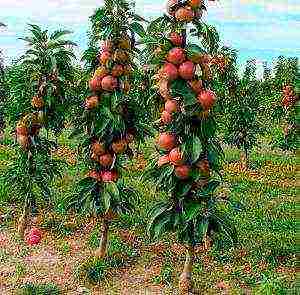Content
- 1 What varieties of plums are most suitable for giving
- 2 Early varieties of plums
- 3 Mid-season plum varieties
- 4 Late varieties of plums
- 5 The best varieties of plums
- 6 Description and characteristics of the best self-pollinated varieties of plums
- 7 The best yielding varieties of plums for a summer cottage
- 8 What frost-resistant varieties of plums are best planted in the Moscow region and central Russia
- 9 The best frost-resistant varieties of plums for Siberia and the Urals
- 10 A little about classification
- 11 Early
- 12 Mid-season
- 13 Late
- 14 Yellow
- 15 Sweet and large
- 16 Other varieties of plums
When creating your summer cottage garden, you always want the work done to be in vain and eventually bear fruit. There are many fruit trees that are perfect for home growing, but it is worth remembering that each plant variety needs its own conditions, climate, soil, moisture, and more.
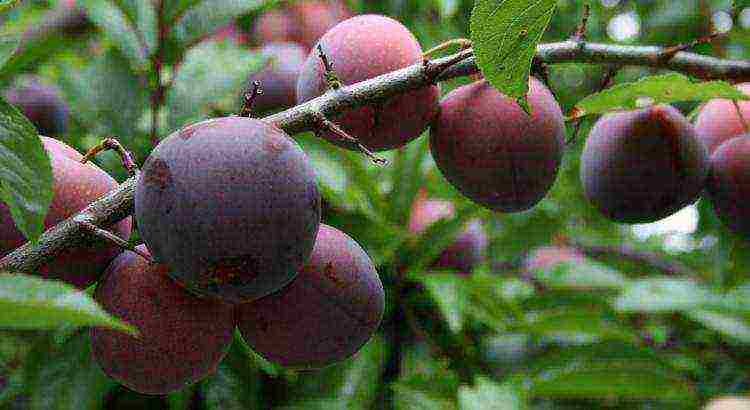
What varieties of plums are most suitable for giving
Plum is one of the most common garden trees, but it is worth remembering that this plant is extremely whimsical and requires constant care. Correctly selected seedlings will delight the gardener with their berries throughout the summer. Also, plums make excellent preparations for the winter in the form of compotes, preserves and marmalades. It is better to give preference to varieties of plums that are suitable for the terrain in terms of climatic indicators and soil characteristics on the site.
There are three main groups of plum trees, most of them take root well throughout Russia, but for some reason there is a very small variety of primitive varieties:
- Early ripening and early varieties - begin to bear fruit from the end of July to the first decade of August and are considered the most productive varieties of plums.
- Mid-season varieties - they begin to harvest from the second decade to the end of August and are considered the most delicious and fragrant varieties of plums, gardeners love to store jam and make tinctures from them.
- Late or very late varieties - begin to bear fruit from late August to mid-September, most varieties are frost-resistant, the fruits are used to harvest preservation for the winter.
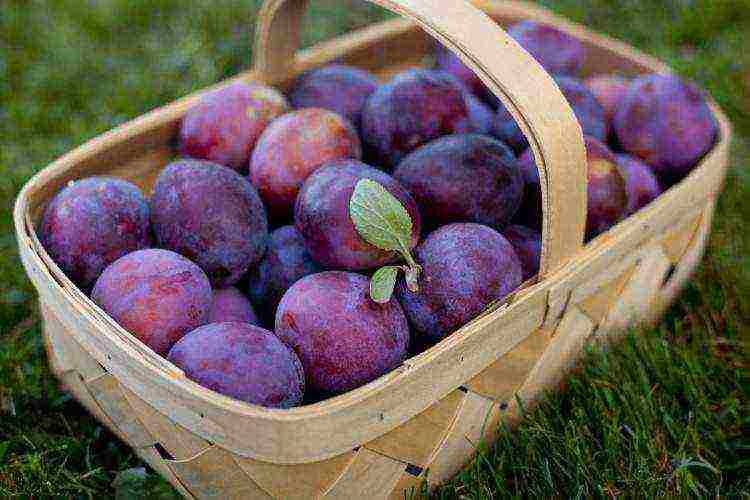
The best varieties of plums for giving
Early varieties of plums
The most optimal option for amateur gardeners, as a rule, trees give a harvest 2-3 years after planting a seedling in the ground, the volume of the harvest increases every year.
- Cooperative - this variety has practically no drawbacks. Typically, the tree is of medium height and has a dense, deciduous crown. The tree blooms in white. The fruits have a rich, reddish-purple hue. The berries are juicy, weighing up to 40 g, very large, regular, oval. The pulp is greenish, dense, has a sweet taste with a slight sourness. The bone is easily separated from the pulp. The first harvest will please in three years at best.
- July plum - a very whimsical tree loves sunlight and does not tolerate high humidity. The crown is not too dense, average yield, up to 10 kg per tree. These are red plums with a pointed oval shape, medium or large in size 30–40 g. The sweet variety of plums has a juicy, yellow center. The seedling will delight with the first harvest already three years after planting.
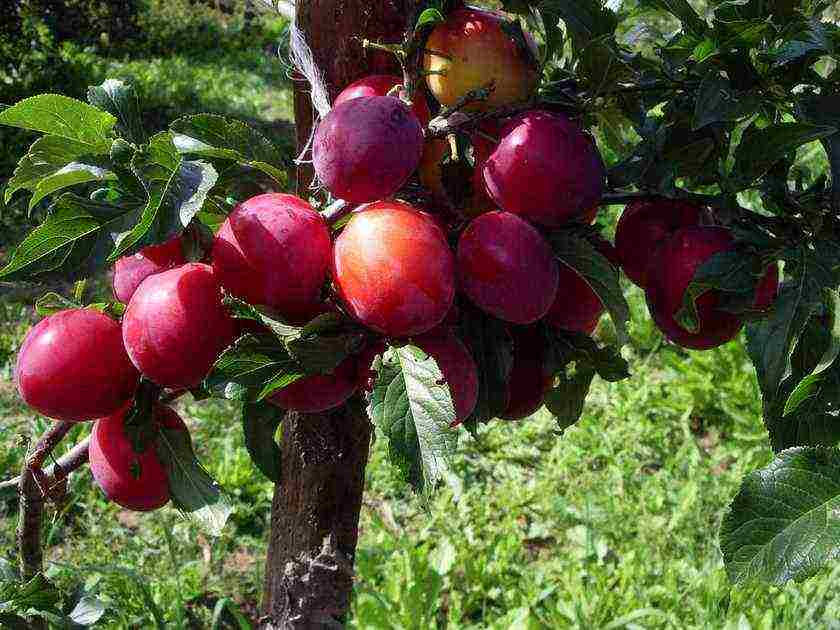
The best varieties of plums for giving
- Plum golden ball Is a variety of yellow plums that has an incredibly pleasant aroma and a peachy finish.The peculiarity of the variety is the high yield of grouped fruits, like sea buckthorn, but at the same time they reach very impressive sizes up to 55g. The seedling will delight with the first harvest already three years after planting in the ground.
- Plum Zarechnaya early - the tree reaches a medium height and has predominantly straight branches. The berries are blue-violet with a white silty bloom, rather large, the inner part is yellow in color with a sour taste. This is one of the most frost-resistant varieties of plums. Gardeners report high yields and disease resistance. Harvesting begins three, maybe four years after the seedling is planted in the ground.
- Plum Early - one of the most frost-resistant varieties of plums. Medium-sized tree with a fan-shaped crown. Red plums have a pleasant, sweet taste, juicy and aromatic. The tree can please with the first harvest already in the second year after planting.
- Red ball - a low-growing garden tree, 2 to 3 meters high. The berries have a rich reddish-amber hue, regular, round shape, large enough up to 45 g. This is a sweet variety of plum, yellowish-white pulp with a rich, pronounced aroma, with a memorable aftertaste. The tree is very fruitful, the first harvest should ripen in 3-4 years, after planting the seedling.
- Plum varieties Record - the tree is very fruitful and frost-resistant. It is rightfully called one of the best varieties of plums for a summer residence, in all respects. The berries are very large, dark blue or purple in color, have a significant waxy film. The pulp can be easily separated from the stone, is quite dense with a yellow tinge, has a very pronounced taste and a pleasant almond aroma.
The best varieties of plums for summer cottages. Photo
Mid-season plum varieties
These plums have a very rich taste and are most suitable for the preparation of fragrant jam or alcoholic tinctures, such trees are often found in home gardens and summer cottages.
- Mashenka - one of the best varieties of plums for summer cottages, has excellent taste. The tree grows medium-sized and cold-resistant, rarely sick and unpretentious to climatic conditions. The berries are dark purple in color, very large. The pulp is dense with a yellowish-greenish color, quite juicy and has a sweet, rich taste, the bone can be easily separated if desired.
- Memory of Babylon - the tree grows to medium size, unpretentious to the climate and grows in cold areas. Berries are bright red, amber, very large up to 90 g. The pulp has a pleasant aroma and pronounced taste with an almond aftertaste, quite juicy.
- Romain - a very productive tree, bears fruit almost every season, the leaves have a characteristic reddish tint. The berries are medium-sized, up to 20 g, red in color, have a rich taste, an amazing almond flavor. The pulp is juicy, deep red.
- Souvenir of the East - low-growing trees with a high yield up to 40 kg per tree. One of the main disadvantages of wood is the instability to cold. The berries are large, maroon or purple in color, have a characteristic sweetish-spicy taste. The flesh is firm and crispy.
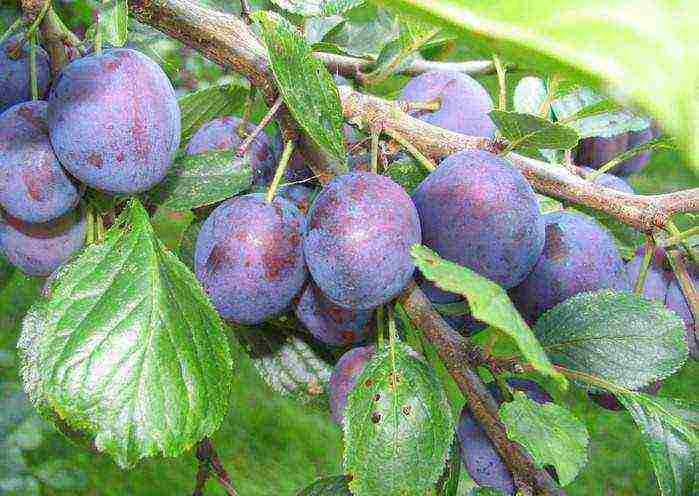
Late varieties of plums
Such plums are the most frost-resistant, but they are inferior in taste to mid-season varieties, while they have a high yield.
- Bogatyrskaya - the tree is unpretentious to climatic conditions, tolerates severe frosts and impresses with its fertility. An adult tree can produce up to 70 kg of berries from one tree. The berries are of a deep dark purple or blue hue, have an elongated oval shape, with a significant layer of waxy bloom. The pulp has a sweetish taste with a slight sourness near the stone itself, yellow in color. The tree is resistant to diseases and parasites.
- Zhiguli - the tree is not very whimsical, it grows in cold conditions and pleases with high fertility.The berries are deep blue or purple in color, reaching an average of 40-50 g. The flesh is greenish, dense and can be easily separated from the stone.
- Svetlana - the tree is not whimsical, resistant to cold, reaches an average height, very fruitful. A variety of yellow plum, has a pleasant sweet taste, rich aroma, juicy, firm pulp.
- Empress - a fairly tall tree, reaching an average of 4 m. Harvesting from one tree is 20-25 kg. The berries are dark blue or purple, not too large up to 45g. The pulp is yellow, juicy, aromatic, it is a sweet variety of plum. The first harvest occurs 4-5 years after planting.
- The president - one of the most versatile varieties of plums. The tree is fairly resistant to frost, the fruits of this plum variety are often used to make prunes. The berries have a rich, dark purple hue. The pulp is yellow light, has a pleasant aroma and rich taste, with a characteristic aftertaste of peaches.

The best varieties of plums
The best varieties of plums are determined by the main indicators:
- Frost resistance.
- Productivity.
- Disease resistance.
- Ripening time.
- The size of the fruit.
- Taste qualities.
- How easily the pulp separates from the bone.
- The whimsicality of the plant.
- Convenience of transportation.
From the examples of plum varieties given above, the most widely used ones can be distinguished.
- Early - Cooperative.
- Average - Mashenka.
- Later - Bogatyrskaya.
Often, amateur gardeners prefer high-yielding varieties of plums, but, as a rule, for home planting, it is better to give preference to less-yielding trees, since branches often break from the abundance of fruits, fruits and taste are unnecessarily crumbled, much worse. The average harvest is 40 kg per tree, which is quite a lot for winter harvesting.

Plum has always been considered the most whimsical tree for the garden. But today many varieties have been bred that allow it to be successfully grown even in the coldest corners of the country.
Let's take a closer look at the most popular new products and old proven varieties of the best plums.
Description and characteristics of the best self-pollinated varieties of plums
Self-pollinated varieties have long won the recognition of gardeners. For a good harvest, one tree is enough, which cannot but rejoice in the presence of a small area. According to summer residents, from self-fertile varieties, you should pay attention to the following varieties:
• "Bogatyrskaya";
• "Viola";
• "Memory of Timiryazev".
Plum variety "Bogatyrskaya" considered one of the most fruitful among self-fertile varieties. The tree bears fruit early, within five years after planting, at least three buckets of plums can be collected. The yield increases gradually, reaching up to 60 kg per tree. An adult tree produces at least 80 kg of fruit. The fruits are large, elongated, dark purple in color, sweet and sour. They tolerate transportation well. The massive harvest takes place in the second half of August. The tree is vigorous, withstands frosts, is resistant to major diseases, which is good for the climate of the middle zone.
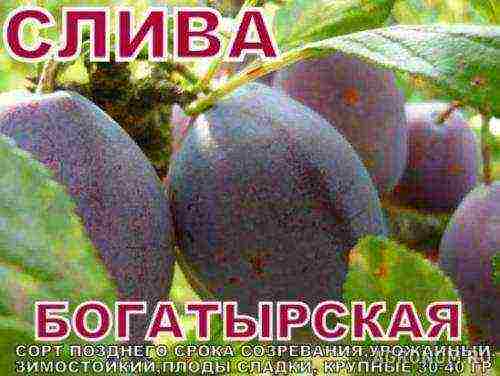
Of the blue plums, you can distinguish variety "Viola"... The tree will delight you with fruits in three years, on average, you can collect up to three buckets of harvest. Plums are of medium size, sweet and sour, quite juicy. The variety is medium-sized, frost-resistant, rarely affected by diseases and pests. The fruits tolerate transportation well. Plum is grown in the middle lane. In dry summers, problems arise with cultivation, the ovaries crumble, the fruits become smaller.
Proven is considered no less productive grade "Memory of Timiryazev"... The tree can withstand a drop in temperature to -30 ° C, at lower rates, buds suffer, and yield decreases. Plum fruits appear in the fourth year of cultivation. The average yield of a young tree is from 10 kg, with age it increases to three buckets. The fruits are medium in size, yellow, with a characteristic reddish blush.The pulp is dense, juicy, well separable, sweet and sour taste. The variety is zoned for central Russia.
The best yielding varieties of plums for a summer cottage
When laying a garden, you should take a closer look at the fruitful varieties that consistently bear fruit, despite the vagaries of the weather. Of these, gardeners identified several of the most promising:
• "Morning";
• "Interesting";
• Valor.
Variety "Morning" gives good yields, is planted as a pollinator for many self-fertile plums. The variety is early maturing, the mass harvest begins in early August. At least a bucket of plums is harvested from a young tree; with age, the yield increases to 25 kg. Fruits are yellowish-green in color with a characteristic bloom, juicy, tasty and aromatic. The stone is small, the plum peels well. The tree is undersized, begins to bear fruit after 4 years of cultivation, it has good immunity. The frost resistance is average, the buds often freeze, but the plum quickly recovers. The variety is recommended for cultivation in the Central region.
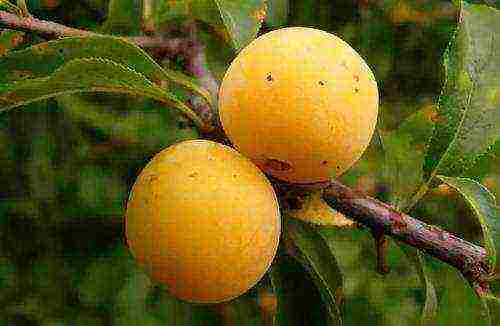
Plum "Amusing" - a relatively new hybrid for the Central and Middle Lane. The variety is self-fertile, planted next to pollinators. The yield reaches three buckets. Fruits are yellow-green, round, sourness is present in the taste. The color of ripe fruits may change, becoming more orange.
Of late-ripening varieties, it stands out plum "Valor"... The tree is self-fertile and needs pollinators. A variety for industrial use, bears fruit steadily, yields at least 30 kg of fruit. The plum is large, maroon, with a characteristic waxy bloom. The pulp is pale yellow, juicy and sweet. The bone is well separable. A multipurpose variety, mass harvesting begins in the first decade of September.
What frost-resistant varieties of plums are best planted in the Moscow region and central Russia
In the conditions of the middle lane, it is worth taking a closer look at varieties that are highly resistant to diseases and resist the vagaries of the weather well. These include plums:
• "Fast-growing";
• "Red ball";
• "Yakhontovaya".
Plum "Early" considered the best for the Moscow region and the middle zone. The variety is completely self-fertile, bears fruit stably, high yields. The first plums appear in the third year of cultivation; with age, the yield reaches 30 kg per tree. Plums are yellow-red with sweet pulp, large, well transported. The tree is early maturing, harvesting occurs at the beginning of August. Frost resistance up to - 40 ° С, good immunity.
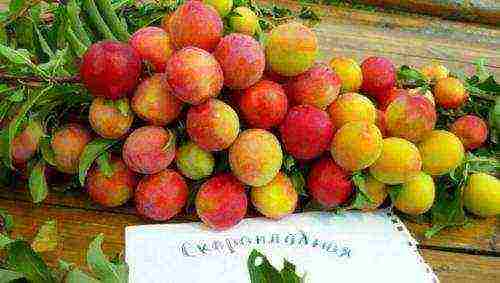
Variety "Red ball" partially self-fertile, productivity increases with pollinators. The first fruiting occurs in the third year of growing the seedling. On average, 18-20 kg are harvested from a tree. Fruits are large, red, with yellow juicy pulp, sweet. The variety is resistant to major diseases.
Frost resistant and early ripe grade "Yakhontovaya" will delight with the harvest in three years. The tree is vigorous, partially self-pollinated, tolerates temperatures down to -30 ° C well. Fruits are yellow with a characteristic bloom, sweet and sour in taste, large, ripen in the second decade of August. At least 30 kg are harvested from one tree.
The best frost-resistant varieties of plums for Siberia and the Urals
In the Siberian climate, plums are rarely grown. Preference is given to seedlings grafted onto the most cold-resistant crop - the Ussuri plum, which easily tolerates frosts down to -50 ° C. The most productive varieties are considered:
• "Uvelskaya";
• "Yellow Hopty";
• "Pioneer".
Variety "Uvelskaya" is self-fertile, hardy and fruitful. The tree is resistant to diseases and pests. Fruits are medium in size, dark red in color, elongated, sweet with some sourness. Fruiting begins in the fourth year of cultivation and is harvested in the first half of August. Plums are suitable for conservation, processing and summer consumption.
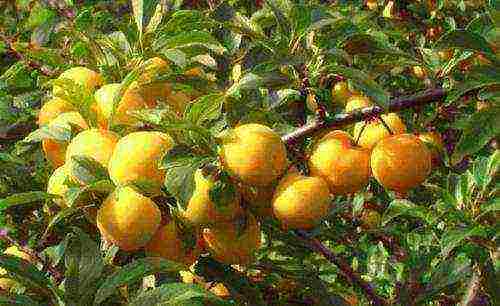
Variety "Yellow Hopty" yields at least 30 kg of plums annually.The tree is medium-sized, frost-resistant, partially self-fertile. Fruits for universal use, ripen by the end of summer, large, bright yellow with a characteristic blush. The taste is sweet and sour, the pulp is juicy. The first harvest is formed four years later.
It is considered very hardy grade "Pionerka"... Medium-ripening tree, partially self-fertile, high-yielding. Fruits are deep red in color with a waxy coating, medium in size. The pulp is juicy, tasty, honey-colored, the stone is easily separated. The average yield is from two to three buckets, up to a maximum of 40 kg of fruits are removed from the tree. Mass harvesting of fruits occurs in the first ten days of August.
.
Due to its beneficial and excellent taste, the plum is very popular among gardeners. Every year, breeders develop new varieties, including self-fertile varieties of plums.
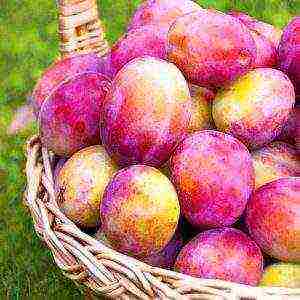
Characteristics of the species
Self-fertile plum trees do not need pollination by bees or pollinating plants. Self-fertile plums are versatile in use.
Of the many advantages of the variety, one can single out:
- 100% chance of harvest;
- lack of pollinators, which saves space in the garden;
- variety of taste and color of fruits (there are trees with yellow, red and blue fruits, different tastes and sizes).
In order to grow plums, it is important to know what kind of care each variety needs, and to give preference to those that suit your climatic zone.
List of varieties
There are not many varieties of self-fertile plums. Varieties with consistently high yields, excellent marketability and fruit taste have become very popular among gardeners. Plum trees can be both vigorous and short, which greatly facilitates harvesting and caring for them. Let's take a look at some of them.
Anna Shpet
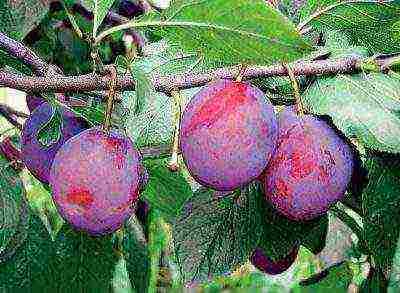
The best self-fertile plum variety to date. Plum Anna Shpet is from Germany. It appeared in Russia after the end of World War II.
Features of this variety:
- The trees are medium-sized (up to 4.5 m in height), durable (up to 40 years). The crown is dense, rounded or round-pyramidal. The bark of the trunk is gray, the bark of the branches is light gray. The leaves are small, the buds are quite tightly attached to each other. Inflorescences are two-flowered, white. Bell-shaped flowers.
- Fruits are large (40-50 g), broadly ovate or oval. The skin is thin, dense, dark purple in color with a red tint. The pulp is light yellow, tender. The taste is sweet and sour. The plum is covered with a thick bluish bloom. The stone is medium in size, well separated from the pulp.
- The variety is distinguished by high yield rates.
- Can be grown in different regions of the country.
You need to plant a tree in an open area, where there is no shade and is spacious enough. There should be no other plantings within 3 meters of the tree that might obscure the plum tree.
The fruits of the self-fertile Anna Shpet plum can be harvested 3 years after planting the tree in the garden. The fruits are suitable for making raisins.
There is only one drawback of this variety - too large a crown that takes up a lot of space in the garden.
Hungarian Moscow
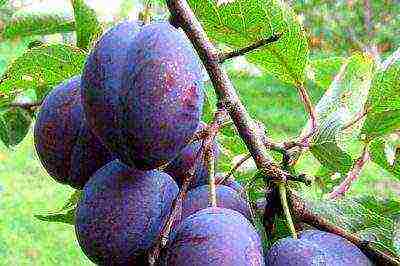
This variety is undemanding and compact, which is convenient for care and harvesting.
Description of the variety:
- The tree is medium-sized - up to 3.5 m in height. The crown is spreading, dense, of the correct spherical shape. The bark is brown. The leaves are green, medium-sized and elongated. Fruiting occurs on bouquet branches after flowering in a one-year growth.
- Fruits are of medium size, ovoid with a pronounced seam in the middle. The color is violet-red or violet-blue. The skin is covered with waxy bloom, rough and tasteless. The pulp is amber, dense, juicy, with a sweet and sour taste. Plums ripen by the end of summer.
The tree begins to bear fruit at 6–8 years of age. There are a lot of fruits, and every year the yield increases.
Hungarian needs good lighting and warmth.Acidic soil is absolutely not suitable for this type of plum tree. The Hungarian can tolerate drought well, but in this case the yield will be less than usual.
Red ball

This variety is a symbiosis of two types: Sino-American Burbank and Ussuriyskiy red. Bred in China. It is one of the most compact self-fertile plums to date.
- The tree grows to a maximum of 2.5 m, the bark is brown. Branches are spreading, in small numbers. The crown is round in shape, does not differ in density. The foliage on the tree appears only after flowering. Flowering occurs in early spring, the flowers are snow-white. The tree is winter-hardy, easily tolerates frost.
- Fruits are red, large (35–40 g), with thin red skin and a slight bloom of blue. The pulp is light, juicy. The stone is medium in size, it is difficult to separate from the pulp.
Variety in Memory of Timiryazev
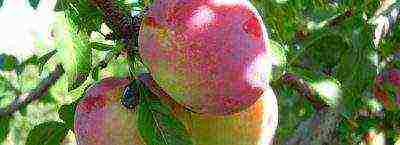
This plum was bred by breeders V. A. Efimov and S. N. Satarov. The tree was obtained by crossing two hybrids - Skorospelka and Victoria. This tree can often be found in Moscow and the Moscow region. Late variety, fruits ripen only at the beginning of September.
- Medium-sized tree, up to 3 m high. The crown is rounded, medium thickening. Leaves are light green, ovoid.
- The fruits are large and of very high quality, oval in shape with a poorly visible seam in the middle. The fruits are yellow, under the sun they acquire a red hue. The pulp is dense, grainy, yellow in color. The taste is sweet and sour.
- The variety has good transportability and versatility in use.
Oryol dream

This plant was derived from the old Annushka variety.
- Plant height reaches 2.5 m. The crown is spreading, medium thickening, pyramidal in shape.
- The fruits are large (40 g), juicy, sweet, with red skin and fleshy yellow flesh. Flowering begins in May, and fruit ripens in early August.
- The advantages of the variety are high winter hardiness and productivity.
Gigantic

This is one of the few self-pollinated varieties that is suitable for growing in harsh climatic conditions, withstands temperatures up to -34 ° C.
- The tree reaches 4 m in height. The crown is dense, pyramidal. Fruiting occurs 3 years after the seedling is planted in the soil. In terms of ripening, it belongs to the middle varieties.
- The fruits are very large (up to 60 g). The skin is dense, pink-red, with a bluish bloom. The pulp is greenish-yellow, sweet, juicy, with a slight sourness. The stone is poorly separated from the pulp. The fruits are versatile in use.
The disadvantages of the variety include poor disease resistance and low drought resistance.
Yellow self-fertile species
The myth that yellow plums can only be grown in the southern regions of the planet has long been outdated. Many varieties have long been adapted to the climate of Russia.
Altai

- Medium-sized tree, with a rounded crown of medium density. The bark is brown-gray. Wood loves warmth.
- Fruits are small (up to 16 g). The shape is round. The color is yellow-orange. The pulp is loose and juicy, which makes it very soft when consumed. The taste is sweet and sour with a characteristic pleasant aroma. The stone is large, easily separated from the pulp.
The best qualities of this variety are very good winter hardiness and fertility.
Renclaude Green

TV takes root mainly in the southern regions, such as the North Caucasus, Dagestan, Crimea.
- A fast-growing tree (up to 6-7 m in height), with an average density of a rounded crown, slightly flattened. The branches are thick, the bark is gray with a reddish tint.
- Unattractive-looking fruits, weighing up to 40 g, become very juicy and sweet during maturity. The shape of the fruit is round, somewhat flattened at the poles. Plum color is yellow-green, sometimes completely green. This is the main difference between the Renklode Green hybrid.
Honey
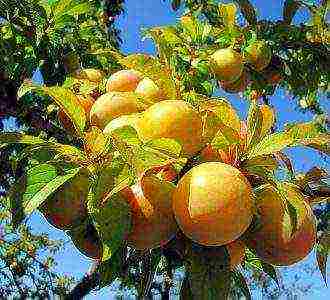
The pride of the famous breeder L. I. Taranenko. The Donetsk branch of the Institute of Horticulture UAAS presented this plum variety to the world.
- The tree is medium-sized, up to 5 m in height.The crown is round, not too thick. Flowering occurs earlier than other varieties, even before the leaves appear.
- Rounded large fruits of yellow color, with a sweet honey taste. The skin is dense, which makes the fruit highly transportable. The pulp is dense, juicy, rich yellow color. The bone is difficult to separate.
This tree is widespread on the territory of Ukraine, in Russia, on the territory of the Crimea.
Golden large
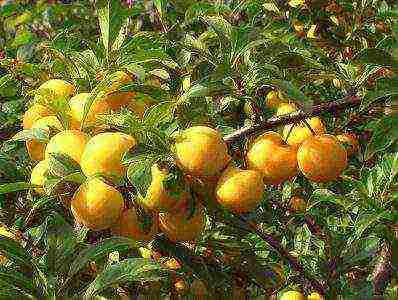
- Medium-sized tree, with a pyramidal spreading crown of medium thickening and foliage.
- The fruits are large (about 43 g), oval, light yellow. The skin is soft, loose, with waxy pubescence. The pulp is yellow, soft and tender, sweet and sour taste. Contains a lot of juice.
- The variety is frost-resistant and gives high yields, the fruits have good transportability.
Early
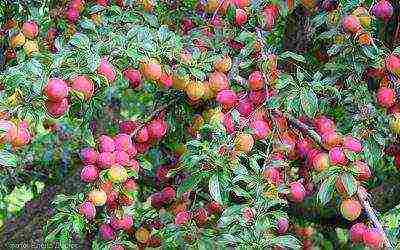
The homeland of the early-growing plum is China. She took root well in the Far East.
- A low-growing plum (2.5 m), with a rounded crown of medium density. The leaves are light green, small, smooth. It blooms earlier than its counterparts.
- Fruits reach a weight of 30 g. The skin is dense, tasteless. Fruit color ranges from bright orange to red. The pulp is yellow, juicy, of medium density. The taste is sweet, with sourness, with a melon aftertaste.
Cherry plum

The massive industrial cultivation of cherry plum in Russia began in the middle of the 20th century. The color of the fruit can be yellow, pink, red, purple or almost black, depending on the variety.
- This multi-stemmed tree can grow from 3 to 10 m. The leaves are elliptical, with a pointed tip. It blooms in the second half of March with white or pink single flowers.
- Fruits are round in shape, weighing 50-60 g. Ripe fruits have thin, yellow skin. The pulp is juicy and very sweet.
According to the ripening period, the following varieties of cherry plum are distinguished:
- Early (Yarilo, Flint, Nesmeyana, Shater, Early comet).
- Middle (Apricot, Chuk. Anastasia, Sarmatka, Peach).
- Late (Krasa Orlovshchiny, Huck, Cleopatra).
Conclusion
Among the variety of self-pollinated varieties, you will certainly find a plant for your garden. Each variety has its own pluses and minuses. If the tree is tall, it is slightly more difficult to care for and harvest than a medium or short plant. But everyone chooses for himself. With good care and favorable conditions, the plum garden will delight you with its spring flowering and rich tasty harvest.
Subscribe Be aware of new products on our site
Plum is one of the most useful and delicious fruits, which contains a large amount of vitamins B, C, E, P, as well as trace elements - magnesium, potassium, calcium, iodine, zinc, manganese. And they are also very beautiful trees, the care of which is not very demanding.
And the taste of plums can be very different - sour, sweet and sour, sweet, tart and soft. If you plan to grow such a tree in your garden, first of all you need to figure out what varieties of plums are, which are suitable for central Russia or for growing in Ukraine, or in another country with a southern or temperate climate.
In this article, you will find a detailed description of the best varieties of plums from which you can choose the right ones.
A little about classification

The principles for classifying these fruit trees are very extensive and include the following characteristics:
- Suitability for food. There are varieties that are considered edible, conditionally edible, and there are also exclusively decorative ones. This point must be clarified by the photo with the name and description before choosing a variety of plums for growing on your site.
- Taste qualities. Here you need to understand that there are varieties, the fruits of which are eaten fresh, but there are - exclusively culinary, that is, for the preparation of preservation (jam, jam, compote, wine, dessert). But among all the selection, you can pick up a universal option, which will be more acceptable when it comes to growing in your own garden.
- Ripening terms... Depending on the characteristics of the climatic zone, as well as personal household habits and the availability of free time in a particular season, you can choose early, mid-season and late varieties of plums. There are even frost-resistant species.
- Color, size, fertility. Here it is already a matter of personal taste for everyone, since you can choose red, blue, yellow varieties of plums, with large and small fruits, with an abundant or not very large harvest - who likes which more.
Only after having dealt with all these criteria and having determined for yourself the priority characteristics of the tree, you can begin to familiarize yourself with the names, photos and descriptions of plum varieties.
Early
All early varieties bear fruit in July and early August. The best according to the opinion of breeders and gardeners can be found in the description below.
July

The tree has an average height and medium foliage, grows well in areas with abundant sunlight on moderately moist soils. When planting, you can expect from 3 years of cultivation for a yield of 12 kg per tree.
Red fruits with sweet yellow flesh ripen at the end of July. The average weight of the fruit is about 30 g, the shape is ovoid. The fruit is best suited for making desserts and preserving.
Zarechnaya early

This kind of plum has fruits with yellow pulp and a pleasant sour taste. There is a slight waxy coating on the surface of the fruit. Trees bear fruit regularly, giving off an average of 15 kg of plums per year, which ripen by mid-July. Zarechnaya early is best suited for harvesting conservation.
Early
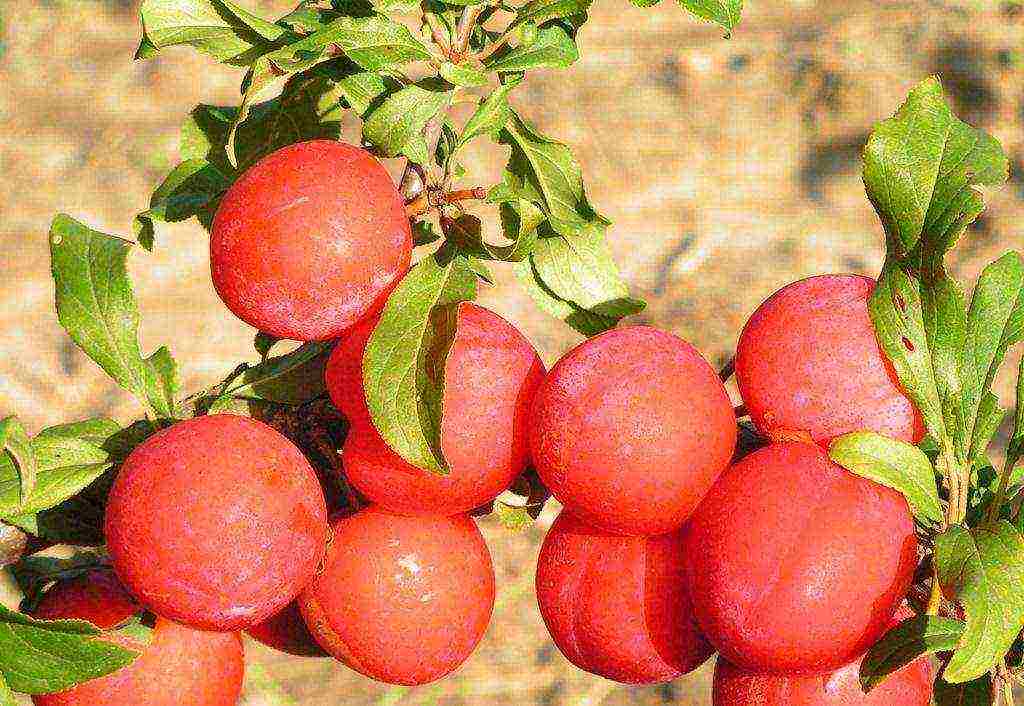
This variety of plum is distinguished by its red fruits with juicy aromatic pulp. Ripening occurs from late July to mid-August. Productivity - average, from 4 years of growth is about 10 kg per tree. This variety is a dessert one.
Etude
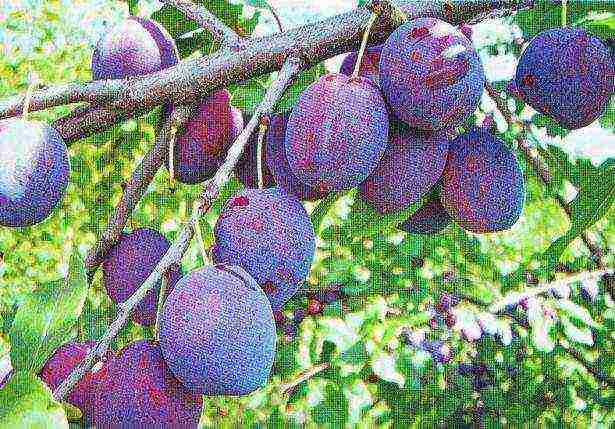
The trees of this early variety are distinguished by a dense crown and medium height. The fruits are purple-red, oval in shape, have a thick waxy bloom. The pulp is juicy, dense, there is a slight sour taste. This variety is favorably distinguished by such qualities as frost resistance and good immunity to various diseases, the ability to store fruits for up to 2 months in a cool room, as well as a high yield - about 20 kg from one tree.
Peach

This is a medium-sized plant with a not very dense crown and large fruits weighing about 40-50 g. But there are also fruits weighing up to 70 g. Fruits are very beautiful - yellow-green, have a purple blush, dense, juicy pulp, sweet and sour taste. An early variety of Peach plum does not withstand low temperatures too well, therefore it will be acceptable, for example, for planting in the Crimea. But it is favorably distinguished by excellent immunity to diseases.
Candy
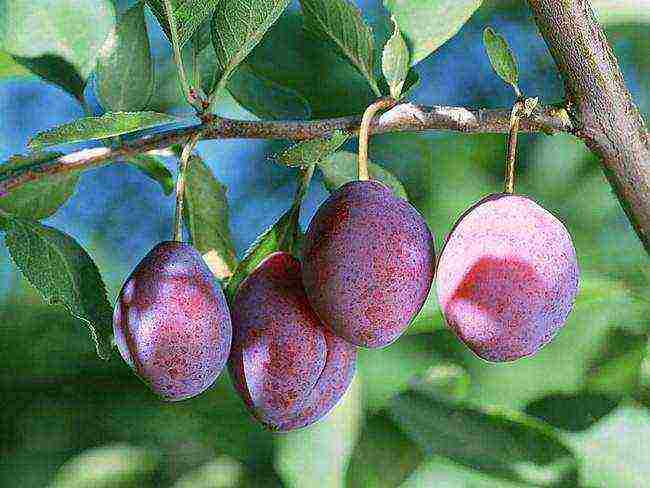
This variety belongs to the category of ultra-early. The trees reach a height of 3 meters, but at the same time they look quite compact. The fruits are medium in size, weighing about 40 g, have a thin burgundy skin and a bluish bloom. This is the sweetest plum with a honey-yellow pulp.
An excellent variety for planting in central Russia and Ukraine, as it firmly tolerates frosts up to 20 degrees and does not succumb to diseases habitual for plums.
Kseniya
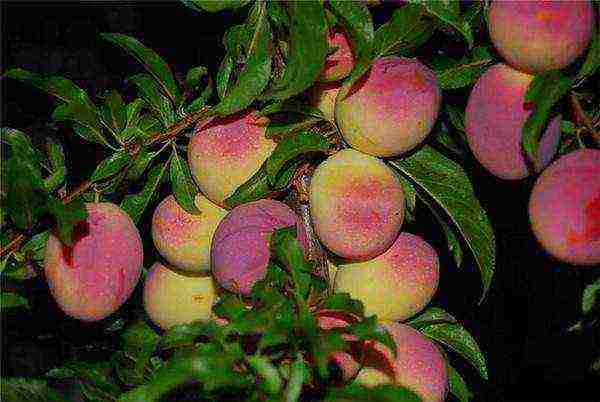
This variety is versatile in terms of the use of fruits. The trees are quite low, the fruit is oval in shape and weighs about 40 g. The color is yellow with a red blush. The taste is juicy and sweet. Fruiting irregularly, but hibernates quite well.
Mid-season
Mid-season varieties ripen from 10 to 25 August.
Souvenir of the East

This is the result of artificial breeding, due to which a very high yield was achieved - an average of 40 kg per tree. The fruits are very large, have a crunchy, sweet pulp. The trees usually grow to a height of 2.5 meters and have a compact crown. The color of the fruit is dark blue, the pulp is yellow, the average weight is 40 g.Excellent as a dessert variety and for preservation.
Romain
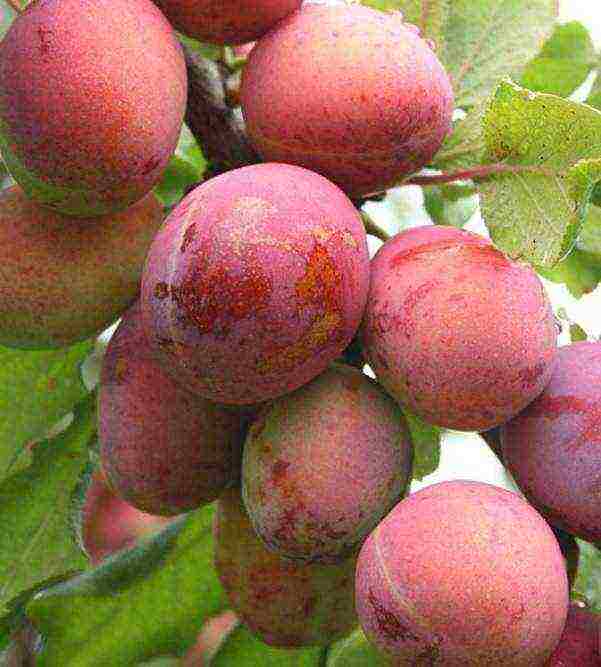
The ripening time of the fruits is the 2nd decade of August. This variety bears fruit regularly. It looks very beautiful on the site, due to the decorative foliage of a red hue. Fruits are small, weighing up to 25 g. A good variety for preservation and as a dessert.
Bogatyrskaya
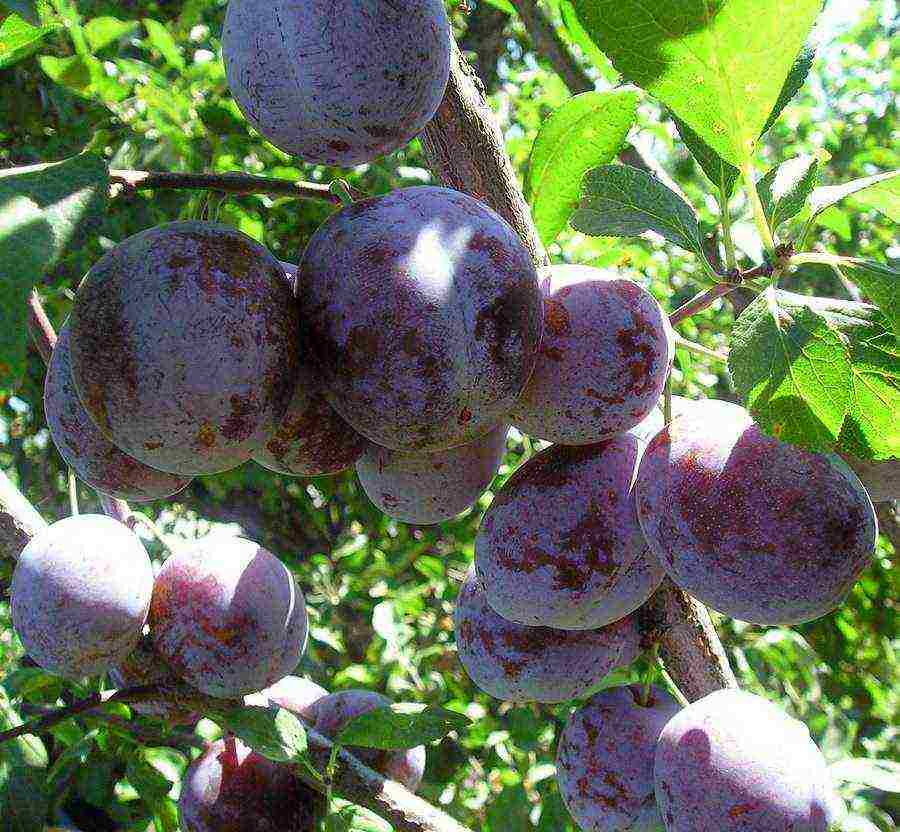
A self-fertile variety of plum, the trees of which are rather short. Fruits are medium in size, oval, slightly elongated in shape, weighing 40 g, rich purple hue, with a waxy bloom. The taste is sweet and sour. Such plants are rarely affected by diseases, pests, do not freeze, and tolerate transportation.
Late
Late plum varieties are those whose fruits ripen from the third decade of August. In some species, this period can last up to October.
Empress

These are tall trees of 4 meters, the harvest from which is harvested from mid-September in the amount of about 20 kg. They begin to bear fruit only from 4-5 years of growth. The color of the fruit is dark purple, the fruit is large, on average 50 g. This variety is most suitable for technical processing and harvesting.
Anna Shpet
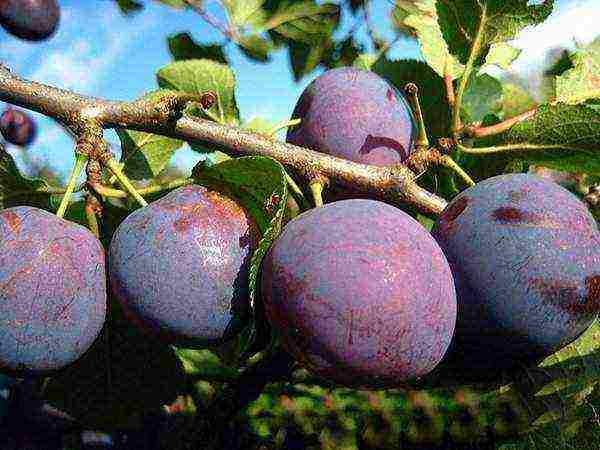
This species belongs to late maturing and very productive, with tall, durable trees. Fruits weighing 50 g, have an oval-ovoid shape with smooth sides, a dense skin of a red-violet hue.
There is a slight coating on the surface, the flesh is very firm and has a greenish color. Great for eating raw, for freezing, cooking dried fruits. It tolerates both low temperatures in winter and aridity in summer, but requires good care and prevention of diseases. Suitable plum variety for growing in central Russia.
Top hit
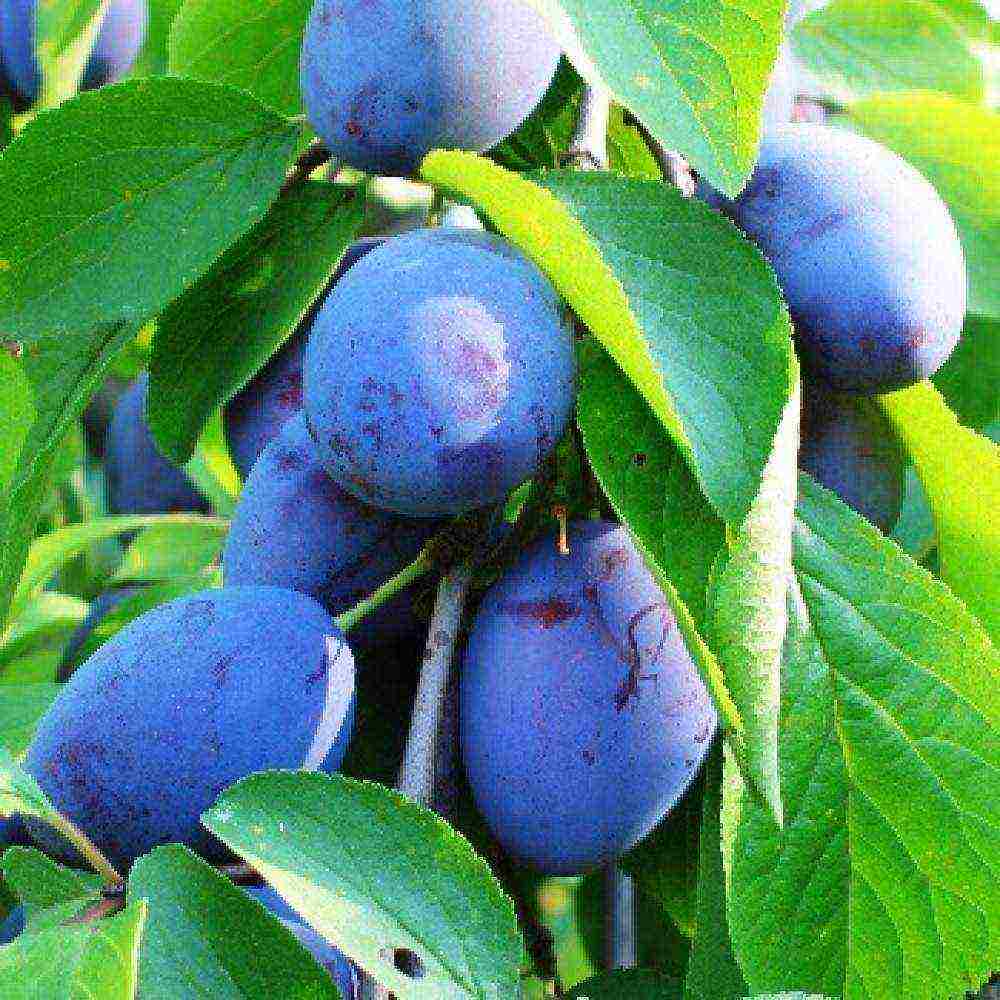
This variety stands out for large fruits up to 80-100 g, tasty juicy pulp with a slight acidity, good long-term storage. Harvested usually in the second decade of September.
The tree begins to bear fruit from 3-4 years after planting. The plant itself is very large and has a spreading crown. Fungal diseases and scabs are usually not affected. It tolerates winter staunchly, therefore it is excellent for growing in Ukraine.
The president
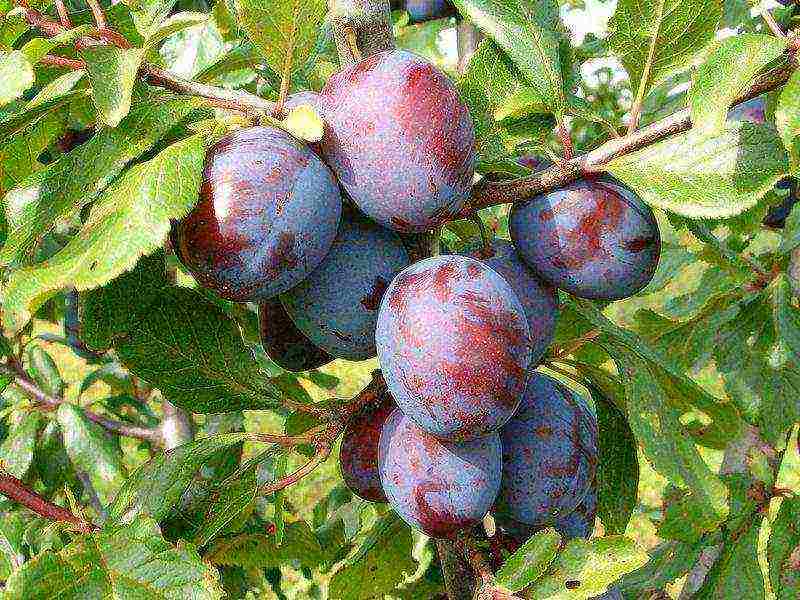
This variety is one of the oldest. It was known back in England in the 19th century. The fruits weigh from 40 to 70 g, uniform, round, can be stored for up to 2 weeks, if they are harvested a week before the final ripening.
But picking the fruit too early is not worth it, since in this case the pulp will be sour, tough and with a rather mediocre taste. The yield is high and increases as the tree matures:
- in a 6-8-year period, you can count on 15-20 kg;
- from 9 to 12 years of growth - by 25-40 kg;
- up to 70 kg from one older tree can be obtained if it is in good health.
The plum variety President is partially self-fertile, develops well in any climatic conditions. Suitable for raw consumption.
General's
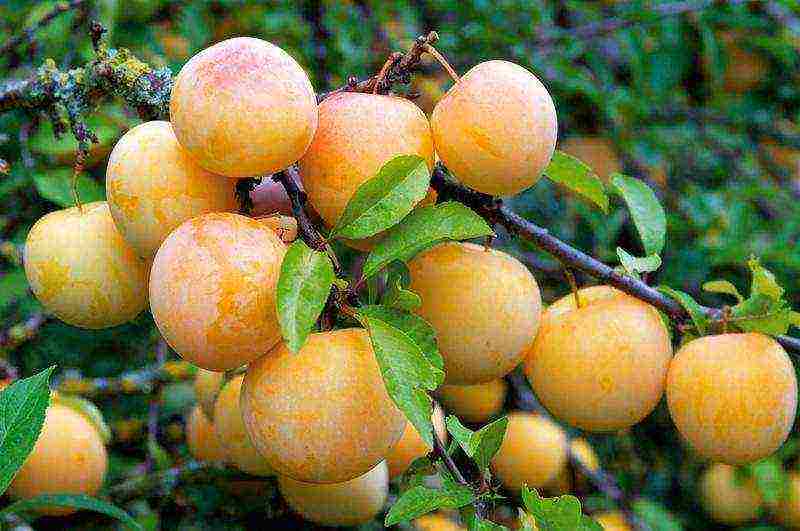
This species is good to grow in the garden for the reason that it is not demanding on the composition of the soil. The main conditions for good growth are sufficient fertility and good loosening of the land. It is better to plant it in early spring.
The trees are compact in size, fruiting with bright orange plums with red barrels weighing 30 g from the 5th year of life, although some begin to bear fruit at the 3rd year.
Low temperatures tolerate well, but only adult and healthy plants. Young when planted in the fall may not survive. Productivity is high, shedding is low. The seeds are well separated from the fruit and are small in size. Great for making compotes, jams.
Yellow
Yellow plums look very beautiful in the garden. These are the varieties that most often receive positive reviews from novice and experienced gardeners.
Golden ball
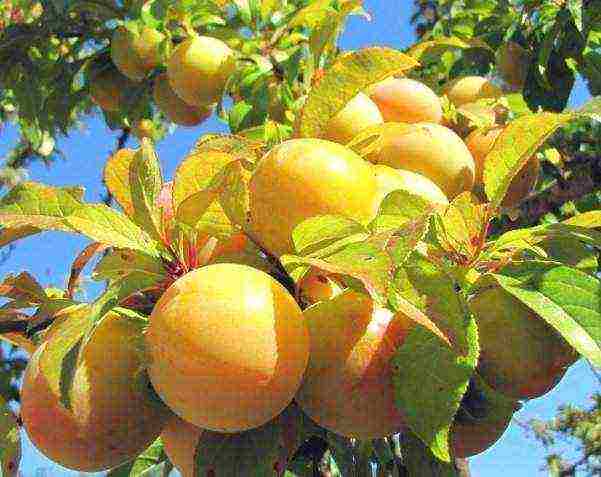
A tall (up to 4 m) tree, the fruits of which have a rich yellow color of the peel and pulp, a pleasant sweet taste, about 60 g in weight and ripen in the first decade of August. The yield is at least 30 kg per tree, since the branches and the fruits themselves are closely located, and somewhat resemble the shoots of sea buckthorn. Of the minuses, the absence of self-pollination and shedding of fruits can be noted.
Egg
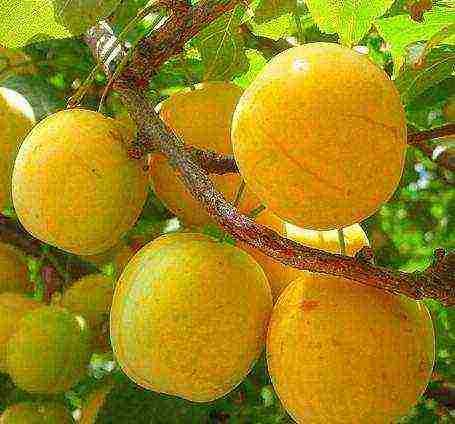
This is a very old variety that has many disadvantages:
- Fruits spoil quickly - already on the 5th day after collection.
- Mediocre sour taste.
- Clingstone.
- The plant is often affected by fungal diseases.
- Begins to bear fruit only from the age of 6.
Nevertheless, it is still grown, since the fruits are excellent for technical processing into marshmallows, compotes. The fruits themselves are medium in size and have a beautiful round shape, and the yield of this variety is 40 kg per tree.
Altai Jubilee
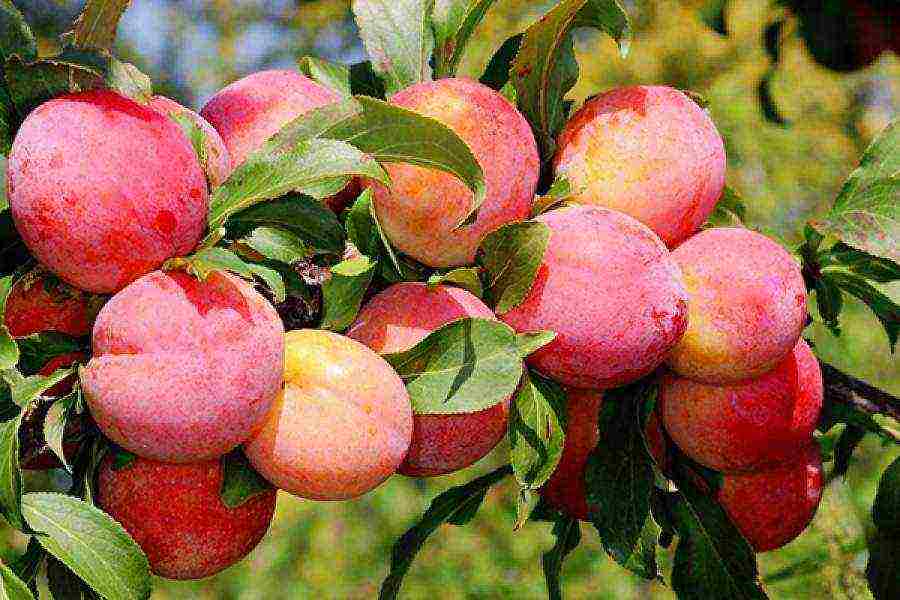
This variety of plum is excellent for growing in central Russia, as well as in the south or in the northern regions. The fruits are yellow in color with a reddish tint, juicy loose flesh. The first appearance of the crop can be expected as early as 3 years of tree development. There are also disadvantages - susceptibility to chlorosis, pests, as well as intolerance to long-term transportation.
Honey white
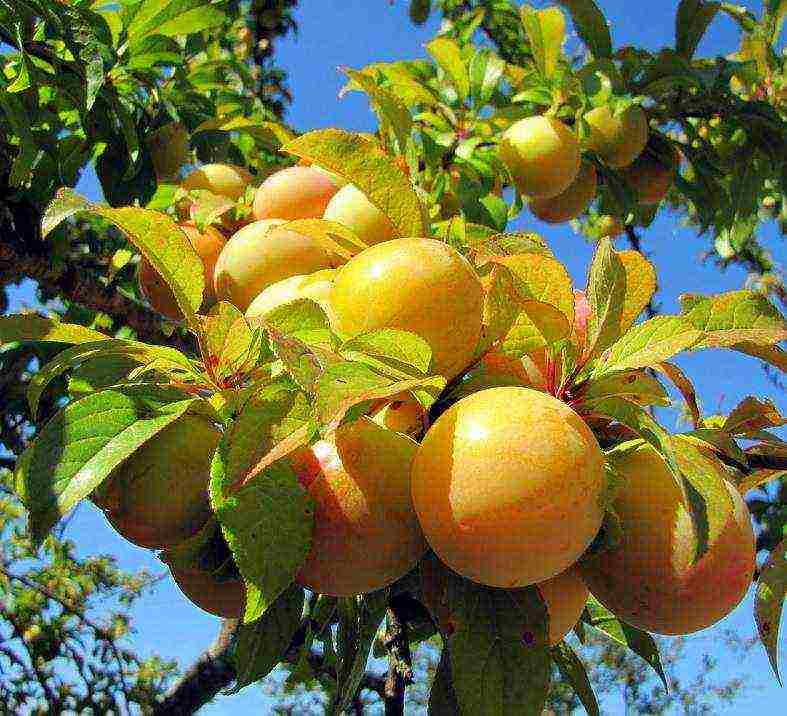
These are very tall trees, up to 5 meters, which give a bountiful harvest and tolerate severe winters well. The name speaks for itself - the fruits are medium-sized and the sweetest, the pulp is juicy. Plums ripen early.
Golden Large

This variety of plums is one of the most popular for cultivation in different climatic conditions, as it perfectly tolerates winter frosts and summer droughts. The palatability of the fruit was rated at 4.8 on a 5-point scale.
Features such as tenderness, juiciness of a pleasant sweet and sour pulp, which literally melts, are noted. The average weight of oval-shaped fruits is 40 g, the color is yellow, with tints of pink, there is a waxy pubescence, which, however, can be easily removed.
Ripening occurs in early October, the yield is about 26 kg per tree. The variety is acceptable for raw consumption and storage.
Yellow afasca
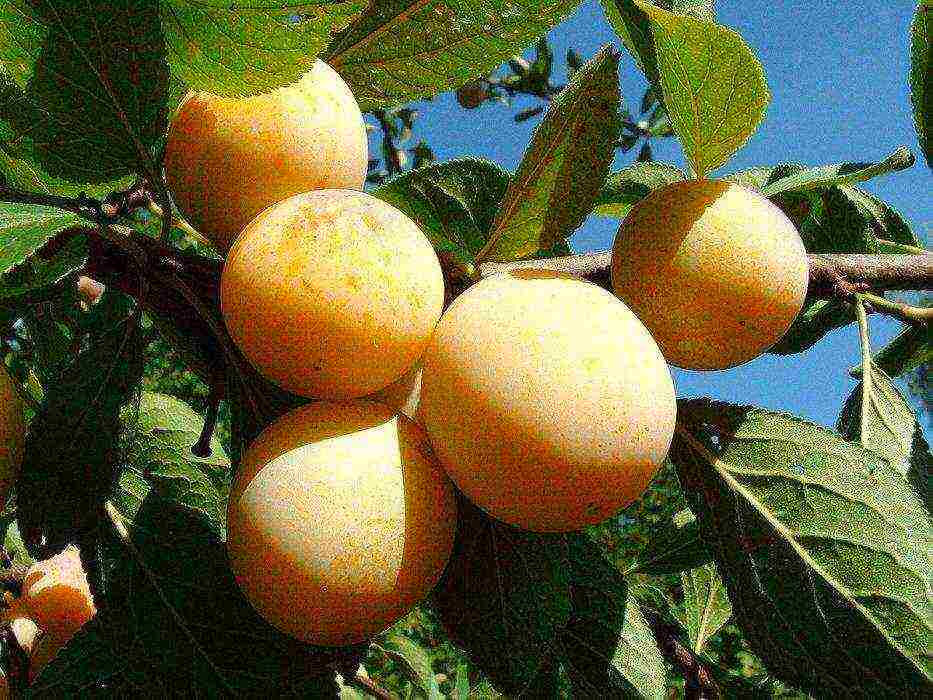
Bred in Bulgaria, but suitable for cultivation in Russia and Ukraine. You can see in the photo that the fruits are quite large, about 60-70 g, the color is yellow with a little green, the taste is sweet, dessert, but they are not stored for very long.
Another important advantage is that you can expect a harvest as early as 2 years of plant life. Winter hardiness, as well as a high immunity to sharka and other diseases of stone fruits are additional factors in favor of growing this variety. The tree itself does not pollinate; it is best to use the American Amers variety for this purpose.
Sweet and large
Giant
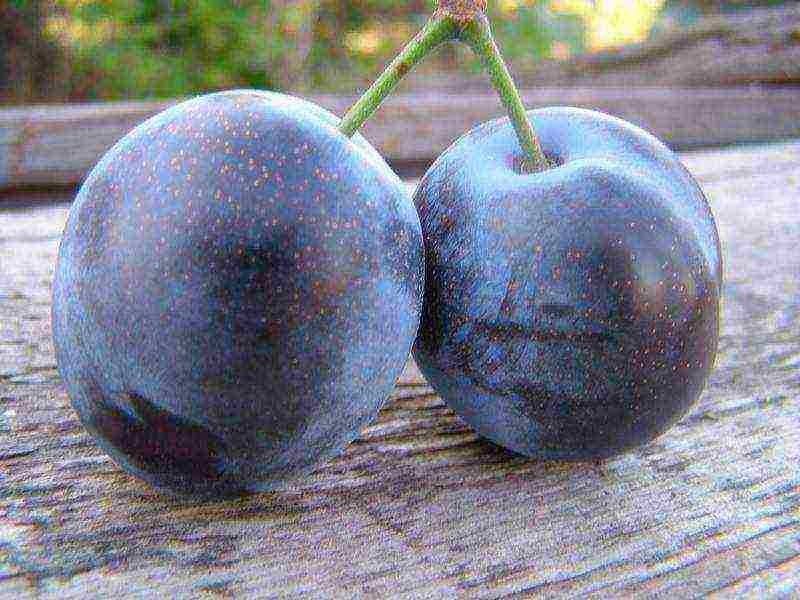
The name is fully justified by the peculiarities of the species. Fruits in weight reach 110 g, can have both purple and yellow, red tint. The taste is sweet, but not cloying, the flesh is tender. Begins to bear fruit as early as 2-3 years after planting seedlings.
The breed does not differ in winter hardiness and requires careful care, since both fungal diseases and damage to the plant by pests are possible. But all the investment of labor pays off with a bountiful harvest of excellent fruits that can be eaten raw and used for canning.
Kyrgyz excellent

The fruits of this variety are dark red or purple in color, sweetness and large size - 60-100 g. The trees are winter-hardy, give a bountiful harvest, bear fruit in July-August. The plants themselves are of medium height, medium thickened spherical crown.
Ballad
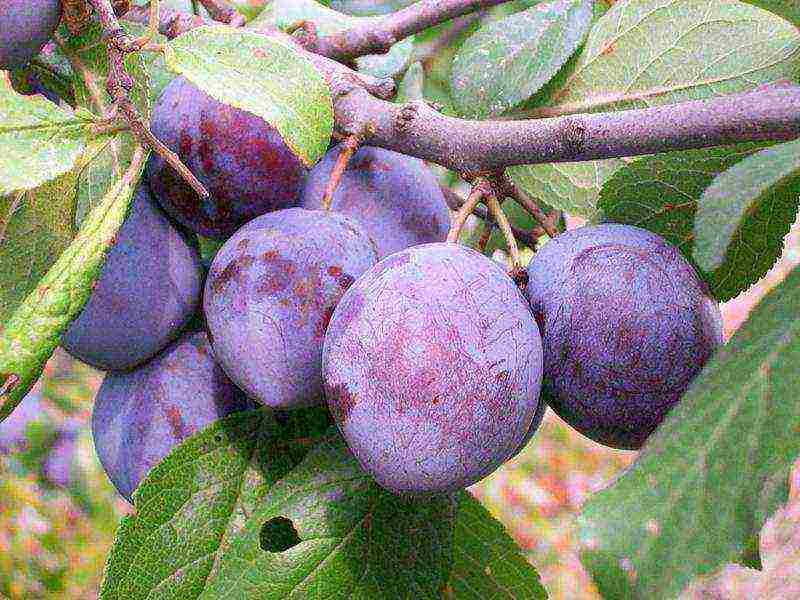
Another sweet variety of plum, however, does not differ in special size - the average mass of fruits of a round shape, red-violet hue is 30-40 g. The stone well departs from the dense, yellow-green pulp. The trees are self-fertile.
Crooman
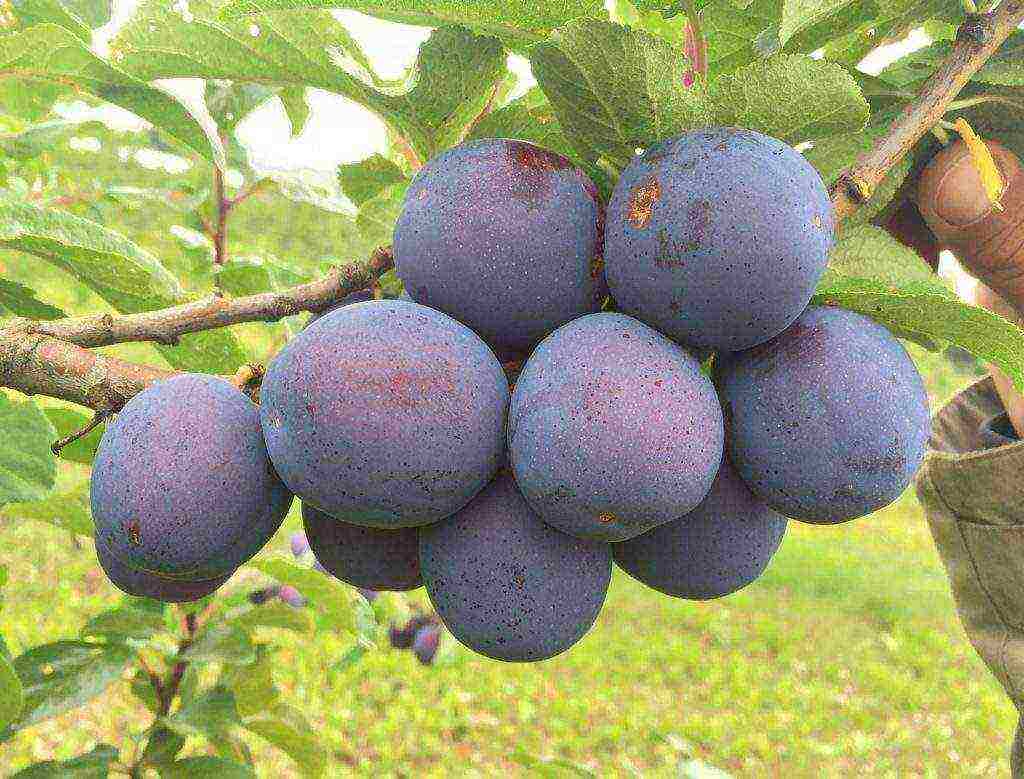
This variety is medium-ripe.The assortment may include dark red, blue, waxy coating fruits. At the same time, the pulp is yellow, sweet, dense, and there is a very small bone in it, which is well separated. This plum variety is resistant to the most common diseases of fruit trees.
Greengage

Very sweet, with hints of honey plum with a dense, juicy pulp. The stone is perfectly separated without any effort, the fruits can be green, blue, yellow - depending on the specific subspecies. The crop is stored for a long time and is easily transported. The average fertility of a 10-year-old tree is 25-30 kg. It goes well both as a dessert variety and for processing for conservation.
Other varieties of plums
- Nenka. Medium-sized trees with a wide crown produce small fruits (on average 20 g), but in large quantities. The shape of the fruit is round. The variety is resistant even to severe frosts.
- Volga beauty. Sweetish-sour fruits of a slightly oblong shape have a mass of 40 g and a moderately dense pulp. It is well preserved, the crop can be transported for a long time, it tolerates winter cold.
- Red ball. Large-fruited dessert variety that looks very decorative on the site. Fruits are juicy, with light yellow pulp, transportable. The plant itself is compact - up to 2.5 m.
- Oh yeah. An excellent option for any soil, including loamy. Productivity is excellent: a tree at the age of 10 years can give up to 80 kg of sweet and sour fruits. A low-growing species, for the development and intensive fruiting of which a sufficient amount of organic fertilizers and regular watering will be required.
- Tula black. Self-fertile, high-yielding species with late ripening and medium winter hardiness. Fruits are oval, medium-sized, dark blue with reddish flesh.
- Crimean beauty. Medium-resistant plum variety, with a reddish-crimson color of small fruits - about 20 g. The stone is semi-detached. Ripens from late July to late early August. It grows slowly, but it is very resistant to any diseases of plums.
We hope that our review of the best varieties of yellow, red, sweet, large plums of different ripening periods helped you choose the optimal species for your site, and you will not be disappointed with either the fertility of the trees, or their health, or the complexity of care.
